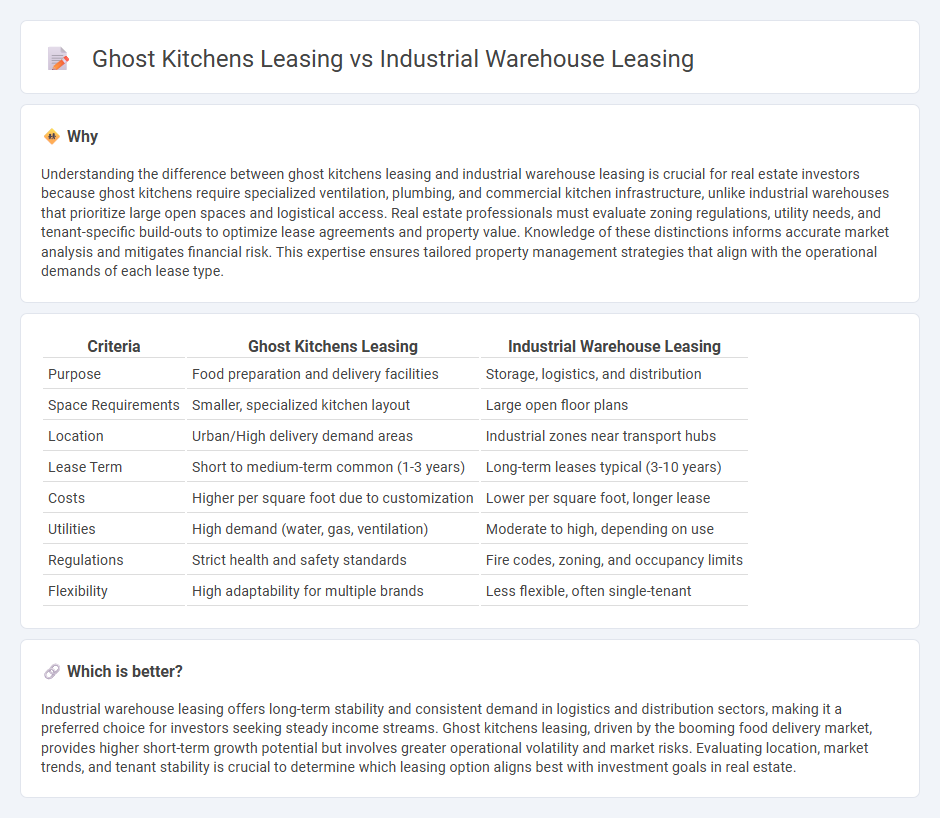
Ghost kitchens leasing offers flexible, scalable spaces tailored for virtual restaurants, focusing on food preparation and delivery, whereas industrial warehouse leasing emphasizes large-scale storage, distribution, and logistical support. The demand for ghost kitchens is driven by the booming food delivery market, while warehouse leasing growth aligns with expanding e-commerce and supply chain needs. Explore the dynamics and opportunities of both leasing models to optimize your real estate strategy.
Why it is important
Understanding the difference between ghost kitchens leasing and industrial warehouse leasing is crucial for real estate investors because ghost kitchens require specialized ventilation, plumbing, and commercial kitchen infrastructure, unlike industrial warehouses that prioritize large open spaces and logistical access. Real estate professionals must evaluate zoning regulations, utility needs, and tenant-specific build-outs to optimize lease agreements and property value. Knowledge of these distinctions informs accurate market analysis and mitigates financial risk. This expertise ensures tailored property management strategies that align with the operational demands of each lease type.
Comparison Table
| Criteria | Ghost Kitchens Leasing | Industrial Warehouse Leasing |
|---|---|---|
| Purpose | Food preparation and delivery facilities | Storage, logistics, and distribution |
| Space Requirements | Smaller, specialized kitchen layout | Large open floor plans |
| Location | Urban/High delivery demand areas | Industrial zones near transport hubs |
| Lease Term | Short to medium-term common (1-3 years) | Long-term leases typical (3-10 years) |
| Costs | Higher per square foot due to customization | Lower per square foot, longer lease |
| Utilities | High demand (water, gas, ventilation) | Moderate to high, depending on use |
| Regulations | Strict health and safety standards | Fire codes, zoning, and occupancy limits |
| Flexibility | High adaptability for multiple brands | Less flexible, often single-tenant |
Which is better?
Industrial warehouse leasing offers long-term stability and consistent demand in logistics and distribution sectors, making it a preferred choice for investors seeking steady income streams. Ghost kitchens leasing, driven by the booming food delivery market, provides higher short-term growth potential but involves greater operational volatility and market risks. Evaluating location, market trends, and tenant stability is crucial to determine which leasing option aligns best with investment goals in real estate.
Connection
Ghost kitchens drive demand for industrial warehouse leasing by utilizing large, flexible spaces optimized for food preparation and delivery logistics. These facilities require strategic locations with robust infrastructure to support rapid order fulfillment and distribution networks. The growth of ghost kitchens influences industrial real estate trends, increasing lease rates and occupancy in warehouse districts near urban centers.
Key Terms
**Industrial Warehouse Leasing:**
Industrial warehouse leasing offers large, flexible spaces designed for storage, distribution, and manufacturing, typically featuring high ceilings, loading docks, and robust infrastructure for heavy equipment. These warehouses are strategically located near transportation hubs to facilitate efficient logistics operations and can be tailored to tenant specifications for scalability and operational efficiency. Explore the key benefits and considerations of industrial warehouse leasing to optimize your supply chain and business growth strategies.
Triple Net Lease (NNN)
Triple Net Lease (NNN) structures in industrial warehouse leasing typically involve tenants covering property taxes, insurance, and maintenance, leading to predictable landlord income and operational efficiency. Ghost kitchens leasing under NNN terms often has shorter lease durations with higher turnover but benefits from reduced common area maintenance costs and flexibility to adapt to evolving food delivery market demands. Explore the distinct financial and operational advantages of both leasing models to optimize commercial real estate investments.
Dock-High Doors
Industrial warehouse leasing typically emphasizes the availability of multiple dock-high doors to facilitate efficient loading and unloading of large freight, critical for logistics and inventory management. Ghost kitchens, by contrast, may lease spaces with fewer or no dock-high doors since their operations prioritize food preparation and delivery rather than bulk shipping. Explore how dock-high door specifications impact your leasing decision between industrial warehouses and ghost kitchen facilities.
Source and External Links
Commercial Warehouse for Lease Los Angeles | Industrial Space for Rent - Leasing an industrial warehouse offers flexibility, lower upfront costs, scalable solutions, and predictable maintenance expenses, making it ideal for businesses that need adaptable storage and operational space, especially in Los Angeles.
LA Industrial Space Leasing: Essential Facts and Tips - Leasing industrial space in Los Angeles can average around $15.11 per sq ft and requires attention to market rents, lease terms, and zoning to secure the best space for your business needs.
Industrial & Warehouse Space For Lease | Greater LA | US - Greater Los Angeles provides diverse industrial leasing options with strategic location advantages, robust infrastructure, and a skilled labor pool, making it a prime area for manufacturing, warehousing, logistics, and distribution businesses.
 dowidth.com
dowidth.com